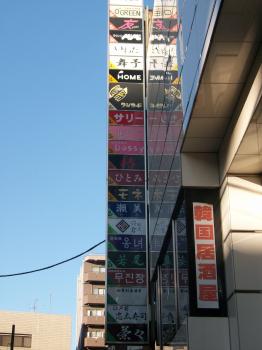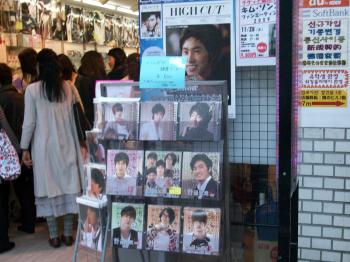
Welcome to Tokyo’s Shinjuku station. One of the world’s busiest. With some two million commuters passing through daily, more than fifty exits and a labyrinth of seemingly endless underground passages, one could easily land up here and not see the light of day, ever. For those of us lucky enough to escape with our minds intact (it’s really not that bad, if your unsure just pick an exit, any will do, and follow the signs with a steely resolve) the ‘city within a city’ of Shinjuku awaits. This is the largest of Tokyo’s sub-centers. Another challenge to our senses.
Spat out of the stations east exit into the brisk light of an autumn afternoon inTokyo, I was in the mood for a stroll. It seems an odd word to use given the manic pace to which Shinjuku moves but oddly enough it’s perhaps the best way to approach this area of Tokyo.
Amidst all the urgency and noise a relaxed, go with the flow, approach is the order of the day. And flow I did, with the rest of my commuters, a few meters from the stations exit to the smoking area opposite the Studio Alta building. As stressed out Salerymen shared cigarettes with Japan’s angst ridden, neo-gothic punks, I squinted through the smoky haze to watch some seemingly bonkers Japanese TV playing on the large screen adorning the studios front.
Two Japanese comedians were jittering on an outrageously garish studio set. The sound and the colors were loud. Too loud as it turned out and I cut my way through the smokers, crossed over Shinjuku Dori and headed down a side street to the left of that big TV. On the corner was a fruit shop selling Durian and other tropical delights spilling onto the street. Momentarily it transported me back to South East Asia. Memories of previous travels came flooding back. It always strikes me as odd that a fruit shop should have staked such a claim in the heart of Shinjuku.

Even more out of place in this mecca of day-glow threads and outrageous mullets was an army of pensioners lining the edgy sidewalks. They were waiting for a fix of Enka at the Koma Gekijo theater. I found a gap in their orderly line and was soon guiltily walking the streets of Kabuki-cho, the red-light district.
On a weekday afternoon it’s a quiet place. The bars were being stocked with beer ready for the coming night and one or two older gents hung onto the curbside smoking their cigarettes. I slowed my pace, trying to take in the salubrious signs that climb up the walls, cursing my inability to read some of the more complex Japanese. Although I felt self conscious of my curiosity about what goes on behind these facades, there was no denying their existence. I let my imagination wander until I came to a busy street. The presence of traffic and people breaking my train of guilty thoughts.
I kept to my line. It took me over the road and guided me into a narrow alley whereupon I was born into a different scene altogether. For a start, the language had changed. Korean. The buildings here were older and lower. Pot plants and bougainvillea encroached my space. The area had a neglected feel to it but only in the finer details. Things just weren’t as neatly arranged. Like a garden that hasn’t been tended in a while. Tucked away either side of me were small bars and eateries serving Korean staples. They looked warm and cozy. An appealing prospect in the autumn chill. Outside their doors they offered a plethora of free publications to guide a Korean community through an ex-pat life inTokyo.
At the end of this narrow ally I took a right onto a busy street and entered what seemed to be the center of this Korean area. Other businesses catering to the community had set up shop off the narrow pavements and a steady stream of Korean and Japanese punters moved by, flirtatiously eyeing up bargains.

The store front of a record shop had pulled in a small crowd, gravitated towards the myriad of Korean pop idol posters that covered every inch of wall space. I paused for a look and tried to make comparisons between Korean and Japanese feather-cut mullets. Both are equally charming and ridiculous, I conclude. More to the point though, this keen crowd in front of this small record shop was a indication of the Korean boom currently happening here in Japan. It’s a boom that sees Japanese females of all ages go weak at the knees for the fellas across the pond. Further evidence of which could be found in those shops making a steady trade in stationary, mouse mats, ashtrays, socks (the list goes on) all with a photo real image of Korean idols lovingly scanned on. The fever in these stores made me nervous and they were no place for idling. I spied a pair of socks that I thought might amuse a friend, handed over my yen to the Korean clerk and forced my out, leaving a crowd of excited women in my wake. I sighed and wondered of a feather-cut mullet might suit me!
Not wanting to go back and negotiate the maze inside Shinjuku station I decided to walk to the nearby Okubo station on the Yamanote line.
As I was on route and taking in my last look around, a warm feeling came over me. I felt very comfortable here among this community of outsiders who, like me, have found themselves on foreign soil. They have made this piece of it their home and affectionately brought some of their comforts with them. Straight away we are on common ground and it makes me feel all cozy and warm. I take time enjoy the thought of cities the world over playing host to their own communities like this. Fellow countrymen seeking each other out as a source of comfort. Leaving behind the reservations and differences that can so often blight a relationship in the motherland. Coming together to face the unknown.